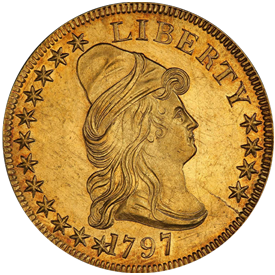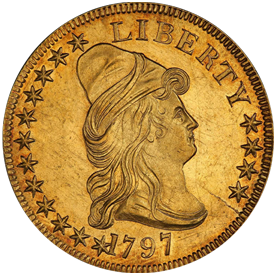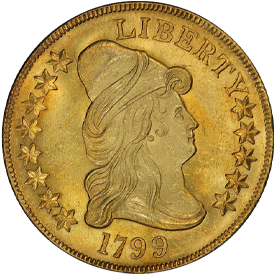Whereas the “Dollar” was the base unit for silver coinage, the “Eagle” (equivalent to ten dollars) was the base unit for gold coinage – and other denominations were typically expressed in fractional parts of that unit. The Coinage Act of 1792 authorized three denominations in gold – the Eagle, the Half Eagle and the Quarter Eagle, and specified the weight and fineness of each.
The first Eagles struck in 1795 were large, impressive coins for the young country. At 33 mm diameter, they were sized between a later Walking Liberty Half and a Morgan Dollar, and struck from .9167 fine gold. The obverse featured a capped bust of Liberty facing right (similar to the early quarter and half eagles) with the word LIBERTY in the upper right quadrant, and stars around the rest of the obverse. A small eagle perched on a branch, with outstretched wings and holding a wreath in its beak appeared on the reverse, surrounded by the words UNITED STATES OF AMERICA. This style continued through mid-1797.
In 1797, a new reverse picturing a heraldic eagle and a ribbon inscribed E PLURIBUS UNUM was introduced, and was produced continually through 1804, with the exception of 1802 when none were struck. A suspension in the striking of eagles then followed, and production did not resume until 1838. In the mid-1830s, a Proof striking was made of an Eagle dated 1804 for inclusion in some presentation sets, and along with the silver dollar dated 1804, are among the rarest and most valuable of all U.S. coins.
All the early (pre-1834) U.S. gold coins are rare, due both to their low original mintage and the mass export and melting which befell most of them. Survivors today are few and far between, and values in the present market reflect that.









